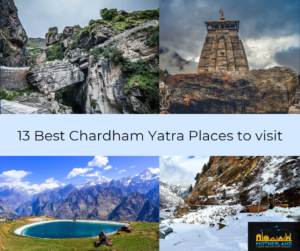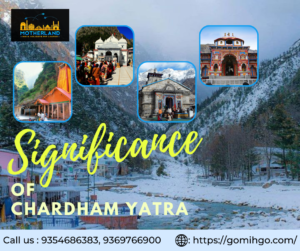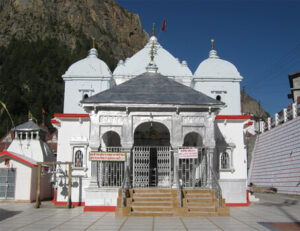Kedarnath Badrinath best time to visit – Motherland India Holidays
Kedarnath Badrinath best time to visit – Motherland India Holidays
If you’re planning a visit to Kedarnath and Badrinath, the best time to go would be between May and June or between September and November. Avoid going during July and August, as it is monsoon season with heavy rainfall and landslides that can hinder travel. During the summer months, nature lovers will enjoy the lush greenery and scenic beauty in full bloom with clear blue skies, while in the cooler months, you may witness snowfall, which adds another level of stunning view.
The temple is open for worship throughout the year except for heavy snowfall in December-January. Overall, visiting Kedarnath and Badrinath in this time frame should ensure a pleasant trip with breathtaking views of the surrounding Himalayan landscapes.
Additionally, the best time for Darshan is from September to November because there are fewer visitors compared to May and June, which is the Kedarnath Badrinath best time to visit for proper prayer and a less crowded experience. The ideal opportunity to perform proper prayer without difficulty is during this time. Additionally, because there is less traffic during this time, you have the best chance to visit a variety of locations. Moreover, compared to May and June, hotel and transit costs are significantly lower during the Kedarnath Badrinath best time to visit.
Although the majority of pilgrims travel around May and June because of India’s summer vacation, they nevertheless believe that this is the best time to visit Kedarnath and Badrinath due to the extensive advertising by travel agencies.
However, when they arrive, they observe a sizable crowd and a protracted queue outside temples for darshan during this popular Kedarnath Badrinath best time to visit. Because of this, it is challenging for devotees, especially those who are elderly, to wait in large lines for Darshan for 6–8 hours.
Due to traffic, not only receiving darshan but even getting to the temple takes significantly longer.
In addition, May and June have substantially higher hotel and transportation costs than September and October, the Kedarnath Badrinath best time to visit.

Recommended Tour Packages
Chardham yatra registration 2023
How can I plan for Chardham yatra
Chardham yatra package from Vijayawada 2023
Weather in Kedarnath and Badrinath

The weather in Kedarnath and Badrinath can be unpredictable, and it is always recommended to check the forecast before planning a trip.
- In the summer months from May to June, the weather is generally pleasant, with warm temperatures during the day and cool nights. However, there may be occasional showers or thunderstorms during this time.
- During the monsoon season from July to October, heavy rain can lead to landslides and road closures, making travel difficult.
- The winter months from November to April are cold, with temperatures dropping below freezing at night. Snowfall is common in these months, which makes visiting these places for tourists a bit of a challenge.
Therefore, it’s advisable to check up on local weather updates regularly while planning your visit so that one may avoid any inconvenience due to bad weather.
Kedarnath to Badrinath distance by road

By road, Kedarnath and Badrinath are separated by 230 kilometers. The cities of Guptkashi, Rudraprayag, Karnaprayag, and Joshimath come into view on the drive from Kedarnath to Badrinath. Depending on traffic and the weather, a road trip from Kedarnath to Badrinath typically takes nine to ten hours. It is a wonderful drive through Uttarakhand’s mountains, with stunning views of the Himalayas, valleys, and rivers.
Distance between Kedarnath to Badrinath
| Distance between Kedarnath to Badrinath by road is | 230 km |
| Distance between Kedarnath to Badrinath by flight is | 41 km |
| Travel time from Kedarnath to Badrinath by road is | 5 to 6 Hours |
| Nearest Airport in Kedarnath | Jolly Grant Airport |
| Nearest Airport in Badrinath | Jolly Grant Airport |
Kedarnath to Badrinath
There are two main routes that can be taken to get from Kedarnath to Badrinath by car. Approximately 211 kilometers of the first root lead from Sonprayag to Badrinath via Maranda. The second group passes via Rudraprayag and is around 230 kilometers long.
You can anticipate taking a taxi or bus to complete the journey in 8 to 9 hours if you choose the first route through Maranda. You will pass a number of beautiful locations along the road, and you might decide to stop at locations like Guptkashi, Chopta, and Joshimath.
The second route, which goes through Rudraprayag, is likewise very picturesque and takes 9 to 10 hours to complete by cab or bus. You can stop at locations like Chamoli, Karnaprayag, and Srinagar along the way.
Whichever root you select, you will be treated to breathtaking views of the Himalayan ranges and get the opportunity to personally experience Uttarakhand’s natural splendor.

Route No. 1: Kedarnath to Badrinath
Sonprayag:- Sirsi- – Phata – Narayankoti – Guptkashi – Ukhimath – Mastura – Makku Bend – Duggalbitta – Baniyakund – Chopta – Mandal – Gopeshwar – Chamoli – Birahi – Pipalkoti – Dwing – Hailang – Nagrasu – Joshimath – Vishnuprayag – Govind Ghat – Pandukeshwar – Lambagad – Hanuman Chatti – Badrinath.
Route No. 2: Kedarnath to Badrinath
Sonprayag:- Sirsi- – Phata – Narayankoti – Guptkashi – Kund – Kakda – Bhiri – Chandrapuri – Agastmuni – Tilwara – Rudraprayag – Ratura – Gholtir – Gauchar – Karnaprayag – Langasu – Nandaprayag – Maithana – Chamoli – Birahi – Pipalkoti – Dwing – Hailang – Nagrasu – Joshimath – Vishnuprayag – Govind Ghat – Pandukeshwar – Lambagad – Hanuman Chatti, – Badrinath
Conclusion
The route via Chopta is indeed shorter than the route via Srinagar. It is important to know that while the shorter route may save time, it may also involve more challenging terrain and road conditions. It is recommended to consult with local authorities and an experienced driver before deciding on a route.
Badrinath Kedarnath Gangotri Yamunotri tour package from Delhi

One of the most significant and revered pilgrimages for Hindus in India is the Chardham Yatra of Uttarakhand, also known as Chota Chardham, which includes Badrinath, Kedarnath, Gangotri, and Yamunotri. Although each of these locations has a unique and storied past, no one is aware of how they came to be connected.
The second-most sacred river in India, Yamunotri, is located in the Uttarkashi district of Uttarakhand and serves as the yatra’s starting point. It is said that taking a bath in this river will atone for all of your sins and bring you Moksha.
Gangotri Dham, which honors Ganga Devi, the goddess who came to earth to atone for all of humanity’s sins, is located in Uttarakhand’s Uttarkashi district.
The Rudraprayag district of Uttarakhand is home to Kedarnath, a shrine to Lord Shiva that local legend attributes to the Pandavas.
In Hindu mythology, Badrinath is regarded as one of the most sacred and holy locations. This Badrinath Dham, which is dedicated to Lord Badri, is a stop on the Chardham and Chota Chardham Yatras.
For those who enjoy walking, this trip will also provide you with stunning locations.
If you’re seeking the much-needed tranquility that seems to have vanished from your life due to the stressful life that city society is offering you, then trust me. You should go to Badrinath, Kedarnath, Gangotri, and Yamunotri. You want to spend all of your time getting lost in these mountains because of the tranquility of the setting.
Everything seems to create an unreal experience, including the weather, beauty, flora, and waterfalls. What are you waiting for, then? Plan this much-needed getaway with Motherland India Holidays Pvt. Limited as soon as you can with a Badrinath, Kedarnath, Gangotri, and Yamunotri tour package from Delhi.
Here is our best-detailed Chardham Yatra Itinerary
Day 01: Delhi to Haridwar (220kms/5-6hr)
On the first day of the Chardham yatra, take a flight or train from your home town airport or railway station; our representative will receive you at Delhi airport or railway station from wherever you reach. You will commence your Chardham yatra by staying overnight at a hotel in Haridwar.
Day 02: Haridwar to Barkot (210 kms/7-8hr)

On the second day, participate in the Ganga Arti in the morning at “Har Ki Pauri” and visit Mansa Devi Temple. In the morning, after breakfast, check out of the hotel and drive to Barkot to continue our Chardham Yatra.
Day 03: Barkot to Yamunotri to Barkot (Drive 45 km)

After breakfast, head to Yamunotri for some sightseeing before starting the 6 km hike from Jankichatti to your first Chardham yatra pilgrimage destination. Return to your hotel for dinner after your tour. In-room breakfast and overnight stay.
Day 04: Barkot to Uttarkashi (Drive 100 km)

In order to continue the Chardham Yatra and reach the next destination, check out of the hotel and drive to Uttarkashi after breakfast.
Uttarkashi is the name of a sacred town in Uttarakhand. Uttarkashi is the name of the city’s capital. The district of Uttarkashi is located along the banks of the Bhagirathi River. The sacred and basic obstacles of Uttarkashi, including Gaumukh, Kedartal, Yamunotri, Divya Shila, and Surya Kund, are located all around Gangotri. There are several well-known tourist destinations for explorers close to Yamunotri, including Saptarishi Kund, Hanumanchatti, Govind Wildlife Sanctuary, and Har ki Doon Valley.
Day 05: Uttarkashi to Gangotri to Uttarkashi (Drive approx. 100 km)

To go ahead with the Chardham Yatra and drive to Gangotri in the early morning.
When you visit Gangotri (a town in the Uttarkashi district in the Indian province of Uttarakhand), take a religious bath in the holy Ganges. On the banks of the Bhagirathi River, close to the Ganges River’s mouth, is a Hindu pilgrimage town.
Because it is thought that Lord Shiva snared the great floods of the Ganges in his tangled locks there, the Gangotri Temple is immensely significant to everyone.
Day 6: Uttarkashi to Guptkashi (Drive 223 km)

While en route to Guptkashi during the Chardham Yatra, our driver will stop at the extremely well-known Tehri Dam. A person can check into the hotel upon arrival in Guptkashi. However, it is advisable to visit the well-known temples in the area in the evening, such as Ard Nareshwar Temple and Kashi Vishwanath Temple.
Day 7: Guptkashi to Kedarnath (Drive 30 km)

Arrive at the transport parking lot at Sonprayag early in the morning. Take a local vehicle/jeep at your own risk to go the 2 kilometers to Gaurikund. Your hike to Kedarnath can begin once you arrive in Gaurikund (16 kilometers one way).
- Those who wish to travel by helicopter, which costs approximately Rs 12000 per person (80kg weight), will be dropped off at the Guptkashi/Phata/Sirsi Helipad. Those who wish to hire a pony or palki at their own expense (approximate cost suggested for a pony for the return journey: Poni Rs 3000/-, Palki Rs. 10000/-).
Day 8: Guptkashi to Joshimath (Drive 160 km)

To continue the Chardham Yatra, we will drive towards Joshimath through Chopta and Ukhimath in the morning after breakfast. Once in Joshimath, check in at the hotel. After visiting the Narsingh Temple in the evening, pilgrims stay the night at the Joshimath Hotel.
Day 9: Joshimath to Badrinath (Drive 45 km)

After breakfast, depart for Badrinath. Once you arrive, check into your hotel. After lunch, go to the temple for holy darshan, or pooja. Pilgrims can see Badrivishal there after taking a bath in the Tapt Kund. Staying the night at the Badrinath Hotel for dinner.
Day 10: Badrinath to Rudraprayag (154 Km / 5 hours)

Visit Vyas Cave, Ganesh Cave, Bhim Pool, the source of the Saraswati River, and Mana Village this morning after breakfast (Mana Village: The First Village of India), then take a car to Rudraprayag. When you arrive at Rudraprayag, check into your hotel. Stay the night in Rudraprayag.
Day 11: Rudraprayag to Rishikesh (Drive 138 km / 4 to 4.5 hours)

After breakfast, travel via Rishikesh to Dehradun. The Shivalik range of the Himalayas encircles the spiritual town of Rishikesh, often known as the “place of sages,” on three sides. It is located on the Ganges River. It is stated that after Raibhya Rishi performed difficult penances, God appeared as “Hrishikesh,” and as a result, this region first became known as Rishikesh. Later, go sightseeing at Laxman Jhula and Ram Jhula in Rishikesh. depart from Haridwar.
Day 12: Rishikesh to Haridwar to Delhi (Drive 237 km/4 hours)
On the last day of the Chardham Yatra, check out of the hotel and make your way to the airport or railway station in Delhi for your flight to Hyderabad in the morning after breakfast.
Badrinath Kedarnath Gangotri Yamunotri tour package from Delhi cost
Looking for a spiritual retreat in the Himalayas? Our (Motherland India Holidays Pvt. Limited) Badrinath, Kedarnath, Gangotri, and Yamunotri tour package from Delhi cost offers an effective solution to plan your ultimate pilgrimage experience. Enjoy an unforgettable journey and immerse yourself in the divinity of these enchanting destinations.
Witness the breathtaking vistas, take dips in sacred rivers, visit ancient temples, and explore the cultural richness of the region with our expert guides.
Our inclusive package covers transportation, accommodation, and meals during your trip, catering to your every need. We understand that spiritual journeys can be subjective, so we offer customizable packages to match your interests and preferences.
To join us on this spiritual journey with ease and at a reasonable cost, make a reservation with us through our website, www.gomihgo.com, right away. You can reach us by phone at the number shown on our website or by email with any questions.
Kedarnath Badrinath Gangotri Yamunotri Map

Depending on your accessibility, you can begin your Char Dham Yatra from Delhi, Haridwar, Rishikesh, or Dehradun. Haridwar is the most popular starting location for the Char Dham, and many pilgrims go there directly to begin their journey.
Location of the Char Dham Shrines (temples)
- Yamunotri is 223 kilometers from Rishikesh.
- The distance between Uttarkashi and Gangotri is 105 km.
- Rishikesh is 223 kilometres away from Kedarnath.
- Rishikesh is 298 kilometres away from Badrinath, and Joshimath is 48 km away.
Char Dham Road Route Plan
Haridwar → Rishikesh → Chamba → Tehri → Dharasu → Barkot → Sayana Chatti → Hanuman Chatti → Jankichatti → Yamunotri → Uttarkashi → Harsil → Gangotri (Gaumukh) → Srinagar → Rudraprayag → Augustmuni → Phata → Sitapur → Guptkashi → Gaurikund → Kedarnath → Ukhimath → Chopta → Gopeshwar → Chamoli → Pipalkoti → Joshimath (Auli) → Govindghat → Hanuman Chatti → Badrinath → Nandprayag → Karnprayag → Devprayag → Rishikesh → Haridwar
Chardham Yatra Package for Senior Citizens

The four sacred sites of Yamunotri, Gangotri, Kedarnath, and Badrinath make up the majority of Char Dham. This pilgrimage begins in the months of April and May and ends around Diwali. The Yatra travels from Yamunotri to Badrinath and back again. Senior adults have a very special place in their hearts for this holy yatra. Many of their religious ideals are expressed in it, and they frequently believe that finishing the yatra will advance their salvation. A unique Char Dham Yatra package for senior citizens has been put together by us.
Motherland India Holidays Pvt. Limited has designed this Char Dham Yatra package with senior citizens in mind. With your family, you can complete the Char Dham Yatra. With cozy lodging, wholesome meals, and hassle-free transportation, this yatra would be a tranquil journey. After making a reservation for a “Char Dham trip for senior citizens,” you shouldn’t be concerned about anything; everything is secure and safe.
Highlights of the Senior Citizens Char Dham Yatra:
- Have a special and relaxing time with this Char Dham Yatra.
- Every transfer would take place in a cool, safe, and hygienic cab.
- During the yatra, you will have wholesome meals.
- The lodging options would be secure, sanitary, and comfortable.
Cost Inclusions:
- Meals included with lodging: breakfast, lunch, and dinner
- Services for comfortable transportation
- Parking fees, tolls, and driver compensation
Cost Exclusions:
- Additional costs for a pony, a ropeway ride, a palaki, and other entry fees.
- Insurance for travel or health care
- Anything that is not listed under “inclusions.”
Can we visit Badrinath in April

April is not the ideal time to visit Badrinath as it falls during the pre-monsoon season. The roads leading to Badrinath are usually closed due to heavy snowfall, and even if they are open, they can be quite dangerous to traverse.
In addition, there may be a significant drop in temperature at night, making the journey uncomfortable for tourists. However, if you’re an experienced trekker or adventurer who doesn’t mind taking risks and braving the elements, you could try visiting in April.
But be prepared for inclement weather and check with local authorities beforehand regarding any potential road closures or hazardous conditions.
Overall, while visiting Badrinath in April isn’t recommended for most tourists due to safety concerns, it can still offer a thrilling experience for those willing to take on the challenge.
FAQs related to Kedarnath Badrinath best time to visit – Motherland India Holidays
When should we go to Kedarnath and Badrinath?
Summers from April to June are the best time to visit Kedarnath temple. These months are also the best time to visit Badrinath temple. Gangotri and Yamunotri lie at a higher altitude, so summer starts a little later there, almost at the end of April.
Which is the best month to visit Kedarnath?
Yet owing to its extremely cold climate, spending your summers in Kedarnath would be a preferable idea – April to June is the best time to visit Kedarnath. This is when the Kedarnath weather is soothing and warm, unlike the chilling temperatures of winter, and you can move around the place comfortably.
Which is the best month to visit Badrinath?
The place is home to the Badrinath Temple, which is highly revered by Hindu devotees. Thus, the best time to visit Badrinath temple is from May to June and September to October. This year, April 27 and November 20 (tentative) mark the Badrinath temple opening and closing dates for 2023. So you can plan your trip accordingly.
In which month does snowfall in Kedarnath?
March is snowbound and offers a freezing climate. Kedarnath is closed and inaccessible during March. April is very cold during the evening and night and pleasant during the day.
How many months will Kedarnath be open?
These four holy pilgrimage sites are open for pilgrims only for a brief six months, which commences in the months of April and May.
At what time is Kedarnath less crowded?
The best time to visit Kedarnath is during the month of May, as soon as the temple reopens, or during September – October, when the crowd is less.
Can we go to Kedarnath anytime?
May to June and September to October are considered the best months to visit Kedarnath.
In which months did Badrinath close?
Badrinath Temple in Uttarakhand is among the four shrines of Char Dham in Uttarakhand. It is among the most visited temples in Uttarakhand and remains open for pilgrims from May to November. The temple remains closed during the winter when the deity is worshiped at Nar Singh Temple in Joshimath.
Does Badrinath have snowfall?
By the end of October, heavy snowfall covers Badrinath like a thick white blanket. Roads to the town are closed due to the extreme weather, and the snow continues to fall on Badrinath till mid-March or early April.
Does Badrinath have snowfall?
By the end of October, heavy snowfall covers Badrinath like a thick white blanket. Roads to the town are closed due to the extreme weather, and the snow continues to fall on Badrinath till mid-March or early April.
What is the age limit to visit Badrinath?
Pilgrims should avoid meeting elders (above 65 years) and minors (below 10 years) during their visits to the shrine. Pregnant ladies, infants, and pilgrims less than 10 years old and above 65 years old are advised to avoid the Char Dham Yatra.
When does ice fall in Kedarnath?
Kedarnath in Winter – From October till March
On which date does Kedarnath close?
The doors close two days after Diwali, i.e., on the day of Bhai Dooj. In 2023, Diwali will be celebrated on 12 Nov, so Kedarnath Temple will be closed on 14 November
Is there an oxygen problem in Badrinath?
Badrinath and Kedarnath Dham are located at a height of almost 11,500 feet above sea level, so the oxygen content in the air is very low.
How high is Badrinath?
Badrinath is located at an elevation of around 3,100 m. Located in the Garhwal Himalayas, on the banks of the Alaknanda river, this sacred town lies between the Nar and Narayana mountain ranges.
Read More
Chardham yatra travel tips 2023
Chardham Yatra in Uttarakhand 2023
Chardham Yatra Package by Train 2023
When Badrinath Dham will close in 2023
Haridwar to Chardham yatra by bus 2023
Chardham yatra from Haridwar by car 2023
13 best chardham yatra places to visit 2023
Chardham Yatra Package from Chennai 2023
What is the last date of Kedarnath yatra 2023
Ultimate Guide to Chardham Yatra by Helicopter
Chardham Yatra by Helicopter Package Cost 2023
Char Dham yatra package for senior citizens 2023
Chardham Yatra Package from Pune by Train 2023
IRCTC Chardham Yatra Package 2023 from Mumbai
What is the minimum time for Char dham Yatra 2023
Chardham Yatra Package From Mumbai by Flight 2023
























































